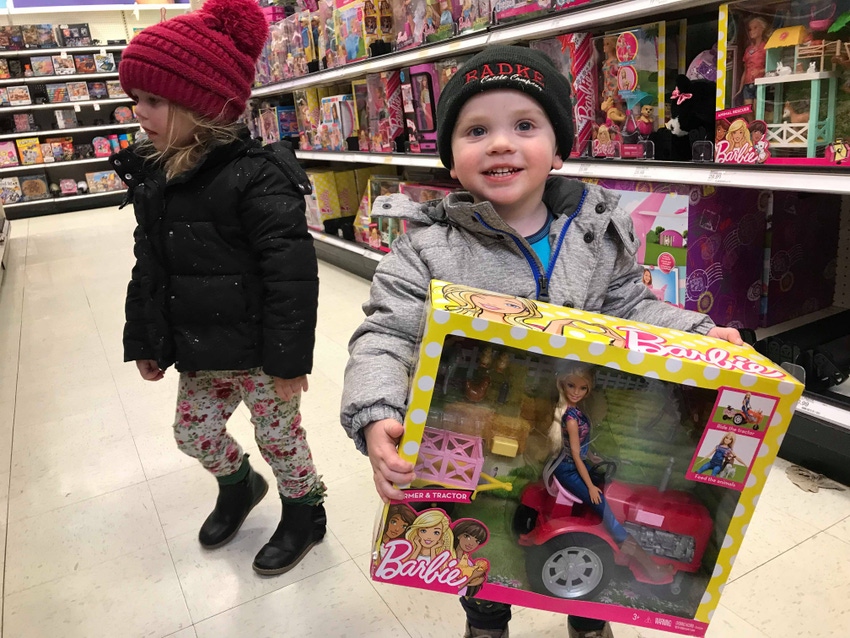Farmer Barbie is a big hit with little kids
This pro-agricultural toy is a sure sign that more consumers want their children to know where their food comes from.
January 2, 2019

Now that the holidays are behind us, I have the fun job of taking down the Christmas tree, packing away the stockings and organizing the countless toys and books our three children received from loving relatives at Christmastime.
When shopping for my kids, I try to choose toys that accomplish a few key things. Before buying, I ask myself a few important questions: Do they enhance my kids’ creativity? Do they support their interests? Do they reflect our lives on the ranch? Do they promote innovation or engineering skills? Do they give them something to aspire to? Will they stand the test of time? Will they hold up to rough use? Will my kids enjoy this for more than a day or two before they’re tossed in the back of the closet? Oh, and let’s not forget the biggie, are they on sale? (I’ve got cows to feed after all!)
After asking these questions, this year our kids received toys like magnetic building blocks, art supplies and of course, lots of tractors and cattle to add to their “basement farm operation.”
Additionally, our 4-year old daughter wants to be a veterinarian when she grows up, so she received a doctor’s kit and several stuffed puppies and kittens to serve as her patients.
Our 2-year old son loves farming, so his prized toy was a combine and grain cart for harvesting corn and beans.
One would think our kids have enough toys to keep them occupied now for months to come. However, last weekend, we attended my sister-in-law’s wedding in Minneapolis. To kill some time before the celebration, we stopped at Target to stretch our legs and get some much needed Starbucks after the six-hour drive in the car.
Naturally, we found ourselves in the toy aisle where Christmas clearance items were abundant. Realizing that a new toy or two would probably help keep the kids on their best behavior at the wedding, we let our two big kids pick out something new. (Yes, I know they’re spoiled, but desperate times call for desperate measures!)
As we browsed the toys, I was surprised when our son passed over the dinosaurs, Paw Patrol figurines and fire trucks in favor of the Farmer Barbie. She’s got it all — a red tractor, pink trailer, overalls and some livestock, too. He’s a man who knows what he likes in a woman, I guess, and she was a hit with our daughter, too!
In recent years, I’ve noticed Mattel has focused on creating Barbie dolls that are more diverse, with various body types, skin colors and even a wider range of careers. Seeing an agriculturally-focused Barbie doll is incredible! This ranch mom approves!
This is the third year Farmer Barbie has been offered in stores. She is teaching kids that anybody can be involved in farming and ranching.
Packaging on the Farmer Barbie reads, “Farmers need to know about weather science, plant science and animal science. From sowing time to harvest, they work the land and care for their animals to help feed the world.”
This Barbie checks off all the boxes for me — she reflects our values; she represents our agricultural life; she promotes an aspirational career field; and she fits in nicely with our daughter’s Barbie collection and our son’s tractor obsession. She’s a win-win in my book!
As a woman in agriculture myself, I truly appreciate seeing an aspirational doll that both my son and daughter can enjoy.
According to Robert A. Hoppe and Penni Korb for USDA’s Economic Research Service, “Agricultural data from 1978 through 2007 shows the share of U.S. farms operated by women has nearly tripled over the past three decades from 5% to 14%.”
What’s more, “Between 1982 and 2007, the number of women-operated farms grew from 121,600 to 306,200, with increases in all sales classes. In contrast, the number of men-operated farms declined by 220,800, with only the largest and smallest sales classes ($500,000 or more and less than $1,000) experiencing growth.”
And while most women-operated farms tend to be very small (earning less than $10,000 annually), 5% of women-operated farms (15,400 farms) had sales exceeding $100,000 per the last census.
Even more interesting, “Nearly half of farms operated by women specialized in grazing livestock. In 2007, 45% of women-operated farms specialized in raising beef cattle (23%), horses (17%), or sheep and goats (6%).”
Of course, more women (including myself) are considered secondary operators by the census, working alongside our husbands in the agricultural enterprise.
According to the report, “Counting secondary operators increases the number of women farmers to 1 million. In addition to the principal operator, many farms have one or more secondary operators involved in daily decisions for the farm. When all women operators, principal and secondary, were tallied for the 2007 census, about 1 million were counted as farmers—up from the 306,200 principal operators and totaling 30% of all U.S. farmers.”
While Christmas may be over and your holiday shopping is finished, perhaps consider buying Farmer Barbie on clearance as a stocking stuffer for next year. Maybe your kids have a birthday coming up, or these would be great for gifts on Valentine’s Day or in the kids’ Easter baskets.
I applaud Mattel for creating a doll that represents the less than 2% of us still involved in production agriculture. It’s a sure sign that more people want to know where their food comes from. Perhaps Farmer Barbie could be a conversation starter with our consumers as parents bond over a toy that kids will love and enjoy.
Help spread the word about this agriculturally-oriented toy by sharing this blog post with someone whose kids might also enjoy the Farmer Barbie!
The opinions of Amanda Radke are not necessarily those of beefmagazine.com or Farm Progress.
About the Author(s)
You May Also Like





